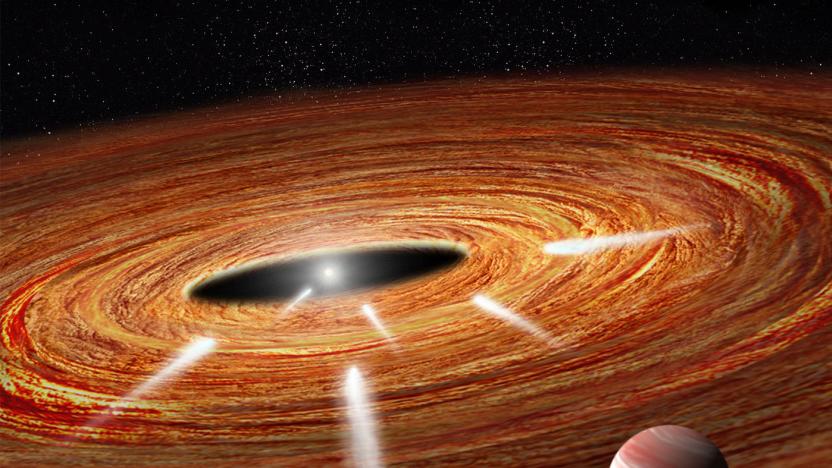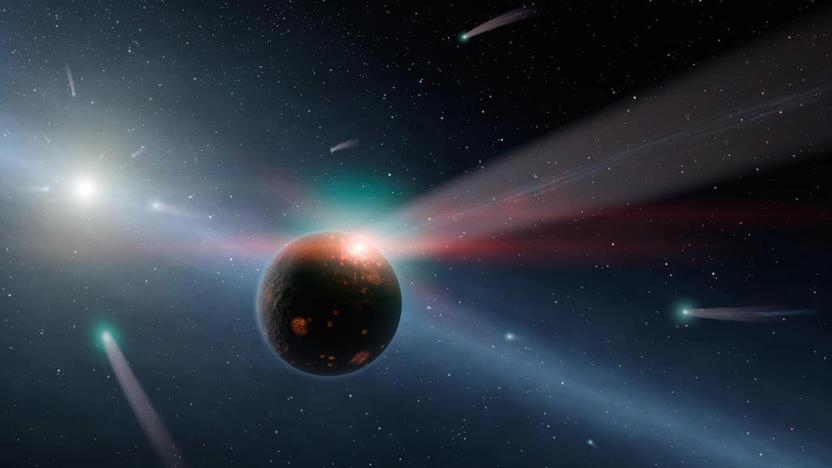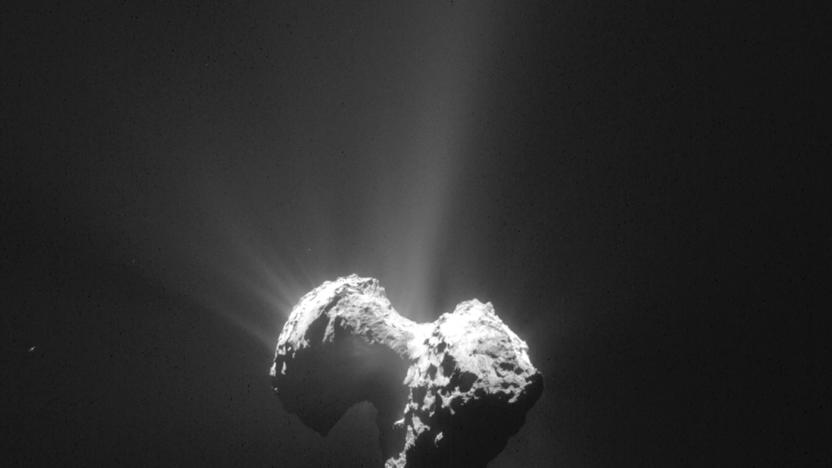comets
Latest

Hubble spots kamikaze comets plunging into a nearby star
The Hubble telescope helped a team of astronomers discover evidence of comets taking a dive into a young star called HD 172555 that's "only" 95-light years away from Earth. While they didn't exactly see these "kamikaze comets," Hubble detected some fast-moving silicon and carbon gases in the starlight close to the edge of the star's debris disk. The most likely explanation for those gases is that they're the result of comet-like objects shattering after crossing the star's disk.

A star will graze our solar system in a million years
In just over a million years, Earth inhabitants will get a closer look at a star than they might want. Gliese 710 is currently a safe 64 light years away, but scientists discovered in 1999 that the sun-like star was barreling directly toward us at around 32,000 mph. We've known for awhile that it would closely pass by our solar system, but Polish astronomers have calculated that it could end up a mere 77 light days away. That would easily be close enough to deflect the orbit of asteroids or comets in our solar system's Oort Cloud, potentially toward Earth.

Rosetta finds key building blocks of life in comet dust
The amino acid glycine, one of the key building blocks of life as we know it, has been found in the "fuzzy atmosphere" of comet 67P Churyumov-Gerasimenko, the European Space Agency announced today. The findings mean it is likely the glycine was carried through space on the surface of the comet.

We're (eventually) doomed: passing stars may rain comets on Earth
There are many things in space that can bring life on Earth to an end, whether they're wayward asteroids or the eventual death of our Sun. However, the chances of a calamitous event may well go up if the calculations of Max Planck Institute scientist Coryn Bailer-Jones are on the mark. He estimates that two orange dwarf stars, GL 710 and Hip 86505, could start messing with comet orbits as they approach our solar system. If they get close enough, their gravitational pull would send a torrent of comets our way and greatly increase the likelihood of an Earth-shattering kaboom.

NASA building a harpoon to fire at comets, suddenly renders plot of 'Armageddon' plausible (video)
Whatever Michael Bay uses to propel that "high-concept" imagination of his, he's obviously passed some of it to the boys at NASA's Goddard Space Flight center. A team there is developing a hollow-bodied harpoon that can be fired from a cannon toward comets too dangerous to land on. Once landed, it fills up with sub-surface samples before winched back aboard the waiting space craft. It's currently being tested by firing the harpoon (using a six foot ballista) into a bucket of dirt -- if they fired it horizontally it'd travel about a mile. After the break we've got video explaining this madness in some detail -- which we promise is Aerosmith-ballad free.

EVE players to tap new resources with Dominion expansion
Big changes are on the horizon for EVE Online in the Dominion expansion and beyond. Alliance sprawl in 0.0 security (lawless) space is going to be curbed, in favor of a new paradigm where alliances claim less territory but can derive much greater value from what they hold sovereignty over. This is the focus of a dev blog from EVE Game Designer CCP Chronotis -- "The Streams Must Flow". Streams in this case refers to EVE's various revenue streams which are going to be altered in the coming months, and how this will affect players in 0.0 alliances. In the past, supporting a large number of players required an alliance to draw upon the resources of many different solar systems, specifically high-bounty pirate NPCs and valuable ores in addition to a very high passive income from rare moon minerals. CCP is adjusting how those rare minerals are used in Tech II production, meaning more common materials will be used, so Dominion will allow alliances to upgrade their controlled space as a means of generating more income.



